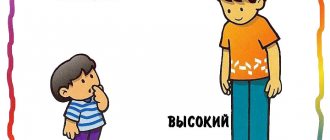Problems of speech development of children in the modern world.
Author: Ruzanova Svetlana Mikhailovna MBDOU TsRR D/S No. 36 Almetyevsk RT
Problems of speech development of preschool children in the modern world.
Recently, there has been an active reform of the preschool education system. A lot of new programs are being published aimed at raising and educating children. But at the same time, very little time is devoted to speech education. In many institutions, speech therapy groups have begun to close, but, nevertheless, according to statistics, the number of speech disorders has tended to increase in recent years. The most numerous category among all preschoolers with developmental disabilities are children with speech defects (from 45 to 60%). Nurturing correct and clear speech in a child is one of the important tasks in the overall system of work of a preschool educational institution. Speech development, including the ability to clearly pronounce sounds and distinguish them, correctly construct a sentence, etc., is one of the pressing problems facing the modern world. After all, correct speech is one of the indicators of a child’s readiness for school, the key to successful development of literacy and reading: written speech is formed on the basis of oral speech, and children suffering from its underdevelopment are potential dysgraphics and dyslexics (children with writing and reading disorders). If violations of sound pronunciation, vocabulary, grammar, phonemic processes are not eliminated in time, preschool children will have difficulties communicating with others, and in the future certain personality changes will occur along the development path “child - teenager - adult”, when a person’s complexness will interfere with his ability to study, and fully reveal your natural abilities and intellectual capabilities. Much attention was paid to the system of training and education of preschool children with speech disorders by: G.A. Kashe, T.B. Filicheva, G.V. Chirkina, V.V. Konovalenko, S.V. Konovalenko and many others.
Speech is a social phenomenon and serves as a means of communication between people. Timely and correct speech development is a necessary condition for personality formation. Thanks to speech, a child learns about the world, accumulates knowledge, and masters norms of behavior. Pure, correct speech is one of the most important conditions for normal human mental development. With the help of speech and communication, a child easily and imperceptibly enters the world around him, learns a lot of new and interesting things, and can express his feelings in words [25, - p13]. E.I. Tikheeva believed that speech is the basis of mental development and the treasury of all knowledge. Concern for the content of speech should go hand in hand, with concern for the construction of speech [41, -p. 7].
An adult must create special conditions for the development of understanding of speech, activation of the speech apparatus, teach the child to use words, evoke the need to speak, and speak correctly and clearly; In addition, the speech of an adult is an object to be imitated, and therefore he must watch how he speaks. [13, с5]
An analysis of the current situation in the system of education and training of preschool children has shown that the number of children with speech development disorders is steadily growing. These children constitute the main risk group for school failure, especially when mastering writing and reading. The main reason is the insufficient development of the processes of sound-letter analysis and synthesis. The process of mastering the sound composition of a word is closely related to the formation of auditory-speech-motor interaction, which is expressed in the correct articulation of sounds and their subtle differentiation by ear [48, p. 9].
The prerequisites for successful learning to write and read are formed in preschool age. It has been established that the age of the fifth year of life is optimal for the education of a special, higher form of phonemic hearing - phonemic perception and orienting activity of the child in speech activity. Underdevelopment of the phonetic side in children is the most difficult in overcoming speech disorders, including defective sound pronunciation; it does not decrease from year to year, but only increases [49, p. 7].
It has been established that in order to master the sound side of the language, it is necessary not only for children to have intact hearing and a sufficiently prepared articulatory apparatus, but also the ability to listen well, hear and distinguish between the correct and incorrect pronunciation of sounds in someone else’s and their own speech, as well as control their own pronunciation. In the process of perceiving someone else's speech, the child must comprehend the content of what is being said to him. By pronouncing words himself, the child not only speaks, but also listens. Children with well-developed speech during communication do not pay attention to what sounds they pronounce and in what sequence [17, p12].
Any speech deficiencies limit a child’s communication with peers and adults and negatively affect the formation of his emotional and intellectual sphere, and can also lead schoolchildren to failure in many disciplines [4, p3].
Education of “pure” speech in children with speech disorders is a task of social significance, and everyone should be aware of its seriousness: speech therapists, parents, educators [40, p151].
Speech impairment remains one of the most common forms of pathology in preschool children. Only correct speech allows a child to study successfully at school. Organizing specialized care for children with speech disorders is one of the important tasks of modern speech therapy, since the number of children with this type of defect is steadily growing every year. The task of a speech therapist is to teach the child to speak correctly and clearly, to help master speech, and to use it correctly. A child’s full speech is an indispensable condition for his successful learning at school. Therefore, it is very important to eliminate all shortcomings in sound pronunciation even in preschool age, before they turn into a persistent complex defect. In addition, it is important to remember that it is during the preschool period that the child’s speech develops most intensively, and most importantly, it is the most flexible and pliable. After all, the ability to use speech is a serious science and no small art.
Bibliography
1. Bogomolova A.I. Pronunciation problems in children. - M. Education, 1979.- 208 p.
2. Gerasimova A.S. Popular speech therapy. Classes with preschoolers. - M. Iris-press, 2009. - 224 p.
3. Efimenkova L.N. Formation of speech in preschool children. - M. Education, 1985. - 110 p.
4. Maksakov A.I. Development of correct speech of a child in the family. - M. Mosaika-Sintez, 2006. - 112 p.
5. Maksakov A.I. Is your child speaking correctly? - M. Education 1988. - 159 p.
6. Stepanova O.A. Preschool speech therapy service. - M. Creative Center Sfera, 2008. - 124 p.
7. Tikheyeva E.I. Children's speech development. - M. Education, 1972. - 173 p.
8. Filicheva T.B., Chirkina G.V., Tumanova T.V. Program “Correction of speech disorders”. - M. Education, 2010. - 272 p.
9. Filicheva T.B., Tumanova T.V.
Children with phonetic-phonemic underdevelopment. - M. Gnome-Press, 1999. - 78 p. comments powered by HyperComments
The most difficult letters
The most difficult for a child to pronounce are the hissing sounds (Zh, Ch, Sh, Shch), as well as the voiced and unvoiced letters Z, G, K, L, S and Ts. But the most problematic letter most often turns out to be the letter R. Moreover, the pronunciation of soft R ( re, ri, ryu) and hard – may not be a problem at the same time. You can read about the letter P here, but what about the other hard-to-pronounce letters?
It is not difficult to teach a child to hiss. The most problematic in this sound are Zh and Sh. And if the letter Sh is quite soft, and its pronunciation does not hurt the ear so much, then with Zh it is a little more difficult. The problem of “hissing” appears because the baby is unable to relax the tongue as much as possible and stretch it. In such a situation, the edges of the tongue should touch the upper lateral teeth, but the baby is unable to do this.
Solving the hissing problem!
When a baby has problems with hissing sounds, he needs to relax his tongue. The following exercises are suitable for this:
- Let's relax. Ask your baby to place his tongue on his lower teeth, as if it were a pancake, and at the same time let him tap his tongue with his upper teeth, saying “ta-ta-ta.” Let the tongue rest a little in the same position, and then slap it with your upper lip and say “pa-pa-pa.”
- Raise the tip of the tongue. Prepare candy or chewing gum, it will serve as motivation. The baby needs to open his mouth 2-3 cm, then put the tongue back, only this time on the lower lip, the tip of the tongue should stick out. Place a piece of sweetness on this very tip, let the child stick it to the palate, so that the candy is behind the upper teeth. But the condition is that the child must use only the tongue, and not the entire jaw.
- Blow out air using the middle of your tongue. Place a small piece of cotton wool on the table. Ask the child to smile and position the tongue in the same way as in the previous exercise. Then the child needs to try to blow off the cotton wool to the other end of the table, but it is forbidden to puff out his cheeks. Ask him to pronounce the letter F at this moment.
- Practice the letter Sh. Have the child pronounce the simple syllable SA. Ask him to hold his tongue behind his teeth at this moment, then, without interrupting the repetition of the syllable, let him move his tongue deeper, but slowly. The further the tongue moves, the more the S sound turns into Sh.
- Practice the letter Z. You need to do the same exercise as the previous one, but instead of the syllable SA, use ZA.
- After such exercises, start giving your child rhymes and tongue twisters with these letters. Repeat them several times.
- Practice the letter CH. When a child has increased tongue tone, difficulties may arise with exercises on this letter, since the sound CH itself is complex. It consists of Ть and Ш. Let the child strike the sound Ть in the mouth, and then relax the tongue and pass the Ш through the slit. Start this exercise at a slow pace. And then speed up. A few training sessions and your child will easily pronounce these letters.
- Practice this letter also with the help of rhymes and tongue twisters.
Solving the problem with the letters Z, S, C
Most often, the problem of these letters comes in the form of a chain. If a child has difficulties with the letter C, then it will be difficult for him to pronounce all the sibilants (З, Ц, Сь, Зь). Most likely the problem is in the underdeveloped speech apparatus, but these problems can also be solved with the help of exercises.
- Football. The child's task is to learn to release a stream of air in a direction. Why the name football? But because the exercise requires scoring goals. Prepare a cotton ball (roll it easily, just not too tightly). Make a goal using cubes (you can buy toy goals), and then ask your child to form a tube and blow on the ball and score a goal. But the task is complicated by the fact that you cannot puff out your cheeks, and the air flow should not be interrupted.
- Tongue hymn (tongue song). Ask your child to place his tongue again on his lower lip. Slap your lips - “five-five-five.” This is the song of the language. The air should come out in a smooth stream and not be interrupted. Then the baby needs to open his mouth and hold his tongue so that it is soft on the lower lip, while the lip should not curl up and the edges of the tongue should touch the corners of the mouth.
- For good pronunciation, the baby must be taught to relax his tongue. This is what this exercise suggests. Let the child smile, place the front edge of the tongue on the lower lip, without straining the smile and hanging slightly from the lip.
- We brush the lower teeth. Let the child move his tongue along the lower teeth in different directions.
If the letter C has its own paired letter Z and they are trained in the same way, then the sound C (T and C) is a little more complicated. After all the exercises, it is important to teach the baby to separate sounds from each other. This can be done through the sound “shhhhh”, which the child needs to pronounce for a long time, and then shorter and shorter. The result will be C.
Complex K and G
Why are these letters sometimes extremely difficult for a baby to pronounce? The thing is that these sounds are back-lingual and require a fairly high elevation of the tongue. In this situation, the child’s tongue is most likely just being lazy, but it’s worth checking the baby for pathology. If the problem is laziness, then simple exercises will help.
- Let's go down the hill. Make a cotton ball and show it to your child. The way he opens his mouth is so that he can keep the root of his tongue slightly raised. The tip of the tongue should be down. Let the child take a quick breath. Everything will work out if the baby manages to blow the cotton wool off his palm and at that time the sound K is produced.
- You will need a spoon. But explain to the child why it is needed, since children do not like having foreign objects put in their mouths. Gently use a teaspoon to move your tongue away, pressing on the front of its back. At the same time, let the child slowly say “ta-ta-ta.” First you get a distorted “cha”, and then “kya”. If you continue to gently press on your tongue, you will get a clear “ka.” This is the moment we need. Let the child remember the location of the tongue. But be patient, this may not happen right away.
The difficulty of pronouncing letters is easy to correct; it requires a pinch of patience and a trip to a specialist. They can help and train children’s pronunciation, but everything will work out for you if you don’t skip training, even if you really want to.
conclusions
Speech development is a complex process, and it occurs differently for each child. If the baby is healthy, speech development occurs naturally when you communicate with him and talk about the world around him. Your child watches you and tries to copy your speech, so it is important to monitor the correctness of your own speech. It is necessary to create a favorable environment for the child in which he can fulfill the needs characteristic of his age. You can offer your child games to develop fine motor skills, as well as introduce them to articulation and finger gymnastics. If you feel that your baby is experiencing difficulties and the development of his speech is far behind the conventional boundaries of the norm, you must definitely consult with specialists to rule out health problems and delayed speech development.






